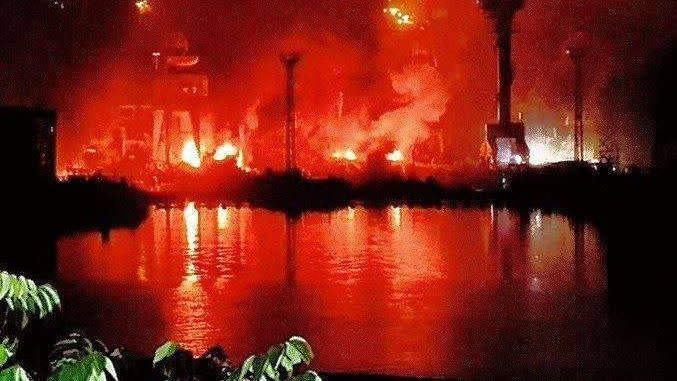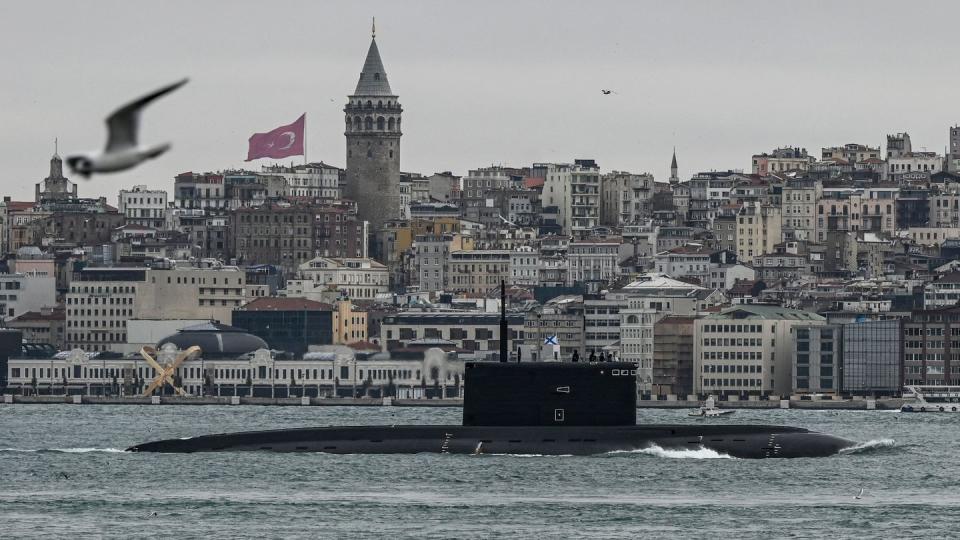Ukraine Completely Destroyed a Beastly Russian Submarine in Drydock

"Hearst Magazines and Yahoo may earn commission or revenue on some items through these links."
Ukrainian air and sea attacks have been continually harrying Russia’s bases in the Crimean Peninsula for a year now—strikes more recently enhanced by the addition of Storm Shadow cruise missiles supplied by the West. So the sounds of gunfire, the whoosh of air defense missiles, and the rumble of distant explosions that shattered the calm in the early hours of Wednesday morning were not extraordinary in themselves.
But then something large erupted on the horizon near Russia’s 13th Ship Repair Plant at 4am. Video and pictures of a huge glowing fire from the drydocks soon made their way onto Russian social media.

A # of Russian Telegram channels posted videos of explosions and a fire reportedly at the 13th Ship Repair Plant in Sevastopol, possibly from a missile strike. https://t.co/Pr645WM7Kthttps://t.co/6vKPel4yhthttps://t.co/jXTfViRBy9https://t.co/6AQB0skAdKhttps://t.co/p13j5iL0gt pic.twitter.com/Fgg1FTPKkn
— Rob Lee (@RALee85) September 13, 2023
Russia reported that Sevastopol had come under a simultaneous attack from 10 missiles and three sea drones—a common Ukrainian tactic designed to overwhelm the defenses—and alleged that Russia’s military had destroyed all the naval drones and downed seven missiles, but that two ships had been “damaged.” In Kremlin-speak, ‘damaged’ may in fact mean ‘damaged’, but sometimes also stands in for ‘destroyed beyond reasonable hope of repair.’
Russian Ropucha-class LST on fire in the Sevastopol drydock pic.twitter.com/boyCrt91xw
— OSINTtechnical (@Osinttechnical) September 13, 2023
Ukraine’s GUR military intelligence agency claimed that two shipyard employees were killed and 26 were injured. A social media post by Ukrainie’s air force chief Lt. Gen. Mykola Oleshchuk implies that manned aircraft delivered the missiles in this attack, likely referring to Storm Shadow/SCALP stealth cruise missiles donated by the U.K. and France, which have been mounted on Ukrainian Su-24M supersonic bombers. These missiles have proven very difficult for air defenses to intercept due to their low radar cross-section.
Other sources have confirmed to media that a Storm Shadow was used, though there are also claims that an extended-range variant of Ukraine’s indigenous land-based Neptune anti-ship cruise missiles were employed. It’s possible both weapons were used in conjunction to confound defenses.
Either way, Wednesday’s strike casts a new light on incidents that happened several weeks earlier—a strike by Neptune missiles, which destroyed an advanced S-400 air defense battery near Sevastopol and a raid carried out by Ukrainian commandos targeting an air defense radar in Crimea. These now look like measures taken to soften up Russian air defenses in advance to set the stage for Wednesday’s successful attack on the drydock.
Sevastapol Shipyard drydock burning post Ukrainian strike pic.twitter.com/9kDxDWFGPs
— OSINTtechnical (@Osinttechnical) September 13, 2023
Analysts noted that satellite photos from earlier that day indicated the two drydocks spots were occupied by a Ropucha-class landing ship and an Improved Kilo-class submarine.
The ‘damaged’ vessels were eventually confirmed to be the Ropucha-class tank landing ship Minsk, while the submarine was B-237 Rostov-on-Don, one of Russia’s newest Project 636.3 Improved Kilo diesel-electric attack submarines commissioned on December 30, 2014.
How serious is the damage?
Russia’s defense ministry has claimed that the two vessels will be restored to operational service. But analysts rapidly concurred that the damage affecting Minsk in particular appears to show it has been outright destroyed, with its superstructure collapsed deep into its hull.
Wow, it looks like the whole structure (outlined in yellow) and the rear AK-725 57mm guns (blue) collapsed into the well dock? This one’s a goner pic.twitter.com/R1ec2hMTYZ
— Mike Yeo 杨启铭 (@TheBaseLeg) September 13, 2023
Video showing the damage of the Ropucha in Sevastopol. pic.twitter.com/4gyBxXaY3S
— Def Mon (@DefMon3) September 14, 2023
Russia began the war with 15 or 16 Ropuchas-class large landing ships, six or seven of which were in the Black Sea when hostilities commenced. As Turkey can forbid reinforcements from transiting the Bosporous Strait, that number is unlikely to increase.
While the Ropuchas were not employed for a risky amphibious landing near Odesa as speculated pre-war due to the intensity of Ukrainian resistance, they have played their part logistically supporting to Russian bases in Crimea and invading southern Ukraine.
Two more Ropuchas were damaged by prior Ukrainian attacks, the Olenegorsky Gornyak by a Ukrainian kamikaze drone boat, and another damaged by a Tochka-class ballistic missile. That same missile destroyed the even larger Tapir-class landing ship Saratov, while a much smaller Project 1170 landing class was destroyed by a Bayraktar drone attempting to resupply Russia’s garrison at Sanke Island.
Cumulatively, these losses—even those that are reparable—reduce Russia’s capacity for amphibious landing operations and more mundane logistics supporting ground forces in southern Ukraine and Syria.
The extent of the damage to submarine Rostov-on-Don was not as immediately clear. This submarine belongs to Russia’s 4th Submarine Brigade in the Black Sea Fleet, which technically disposes of six Varshavyanka submarines and an older Project 877 Kilo, B-871 Alrosa. But only three of those submarines were in operational condition.
The most recent satellite imagery appears to show that the Rostov was also thoroughly roasted in the inferno, and had a crane from the drydock collapse on her deck. It is believes that the cumulative damage will make restoring this submarine to operational condition uneconomical, even if theoretically possible.
Not only the large Russian landing ship 'Minsk', but also the Rostov na Donu (B-237) improved Kilo-class attack submarine was completely destroyed during the recent attack on Sevastopol.
A giant success for the Ukrainian Air Force. pic.twitter.com/vGmyKR2nrz— NOELREPORTS 🇪🇺 🇺🇦 (@NOELreports) September 13, 2023

[/image]
Additional images acquired by the Conflict Intelligence Team non-profit in mid-September show deep, massive ruptures of the pressure hull on the upper bow and rear side hull, with some forensic evidence suggesting that one of the holes was blown out by an internal explosion. Submarine analyst HI Sutton wrote on social media:
“Damage to rear section near propulsion space, as well as bow area, means basically no hull sections are likely salvageable. Implications are that internals are wrecked along most or whole length of submarine... I am confident that any repair (which is anyway unrealistic) cannot be done in Sevastopol. Submarine would need to be patched and towed or on a barge, probably to St. Petersburg.”
CIT received exclusive photos of the damaged Russian submarine Rostov-on-Don. They indicate she received two hits, one of which is not visible from the satellite imagery.
1/2 pic.twitter.com/pYJ5n4n07H— CIT (en) (@CITeam_en) September 18, 2023
A Varshyvanka displaces 2,350 tons submerged and can carry a total of 18 torpedoes—or, notably, Kalibr or Klub cruise missiles—fired out of six torpedo tubes. They have a standard crew complement of 52. While slower and shorter-ranged than vastly more expensive nuclear-powered attack submarines, Russia’s Improved Kilos—or Varshyvankas (Whirlwinds)—are especially quiet, and their short range is not as serious a limitation when patrolling the limited confines of the Black or Baltic Seas.
They do, however, only have battery power for three days of submerged operations before needing to surface or snorkel to run air-breathing generators to recharge batteries. This is unlike non-nuclear AIP submarines in service with Germany, France, Italy, China, Japan, South Korea, Sweden, and other countries.
The modern Project 636 model has garnered export orders from abroad (China, Iran, Vietnam) and will linger in Russian service due to delays and setbacks introducing the succeeding Lada-class diesel-electric attack submarine—which was supposed to have AIP propulsion, but still doesn’t. Already, a new order for six more 636.3 Kilos is expected in 2024.
Russia’s latest Project 636.3 model—all built at Admirality Shipyards in St. Petersburg—also boasts two uprated 1 MW electrical generators, which allow for a greater cruising speed while submerged or snorkeling (3 to 7 knots). It also features sharply reduce acoustic signatures, new seven-blade propellers, and a modernized navigation and combat systems.
Even comparatively cheaper diesel electric submarines are expensive and capable platforms that can pose grave threats even to the largest warships. Thus, the loss of a Kilo will sting, even if they play only a secondary role in Russia’s invasion of Ukraine.
Perhaps even worse than the loss of these two vessels is that their wrecks occupy valuable drydocks (which are also now badly damaged), leaving those facilities unavailable for the repair and maintenance of other ships in the Black Sea Fleet until they are cleared and restored. The fleet’s secondary base at Novorossiysk in Russia has only two floating docks itself, but most of the specialized maintenance facilities are in Sevastopol.
Sevastopol’s viability as a naval base for Russia has been compromised now that ships docked there have proven vulnerable to attack. This may compel a shift of naval assets back to Novorossisyk, reducing the effectiveness of one of three major supply lines sustaining Russian forces in southern Ukraine and Crimea, the other two being a coastal railway line from Rostov, and the Kerch Strait bridge to Crimea.
First submarine combat loss since 1982
It appears Rostov has become the first submarine disabled by a cruise missile (a weapon not traditionally used in anti-submarine role), the first Russian/Soviet submarine lost to enemy fire since World War II, and the first submarine from any nation knocked out by enemy fire in the last 41 years.
Ironically, that loss will have been dealt by an opposing force which mostly lacks any capability to hunt submarines while submerged.
The last submarine lost to enemy action was the Argentinian submarine ARA Santa Fe during the 1982 Falklands War.
Originally commissioned by the U.S. Navy as the USS Catfish, the ARA Santa Fe was assigned to deliver supplies to an Argentinian garrison on South Georgia island, including anti-tank weapons. But after making its delivery and departing at 5:44 AM on April 25, it was detected by a Royal Navy Wessex anti-submarine helicopter, which dropped a depth charge on the still-surfaced sub that ruptured its ballast tank, preventing diving.
A Lynx helicopter from the frigate Brilliant, three Wasps from frigate Plymouth, and ice patrol vessel Endurance joined the sub-hunt. Between them, they pounded Santa Fe with a Mark 46 torpedoes (which missed), an AS-12 anti-ship missile (which pierced clean through the conning tower), and a side-door mounted 7.62-millimeter machine gun.
The Argentinian crew shot back with machine guns and even a Bantam anti-tank missile while the captain ran the badly damaged submarine back to a pier on South Georgia island before abandoning ship. Later that day, the island’s garrison surrendered and the submarine and its crew was captured on April 26—though a captured crew member was shot and killed, some claim while attempting to scuttle the vessel.
Santa Fe's sister ship—the more modern ARA San Luis—had somewhat better luck, managing to launch torpedoes twice at unsuspecting British warships, only for the ‘tin fish’ to malfunction while eluding vigorous Royal Navy anti-submarine hunts.
The world has been fortunate overall to see very limited submarine warfare since the blood-soaked seas of the second World War. And as Ukraine mostly lacks anti-submarine warfare capabilities to hunt for submerged boats, the Black Sea Fleet’s Improved Kilos likely seemed safely insulated from the war, despite their likely contributions to cruise missile attacks on Ukrainian cities.
But just as the most elusive stealth aircraft must eventually land, even the quietest submarines need repairs, refueling, and reloading. And that upkeep period can prove fatal when the home port is close to a country that is very upset at having been invaded without provocation.
You Might Also Like

